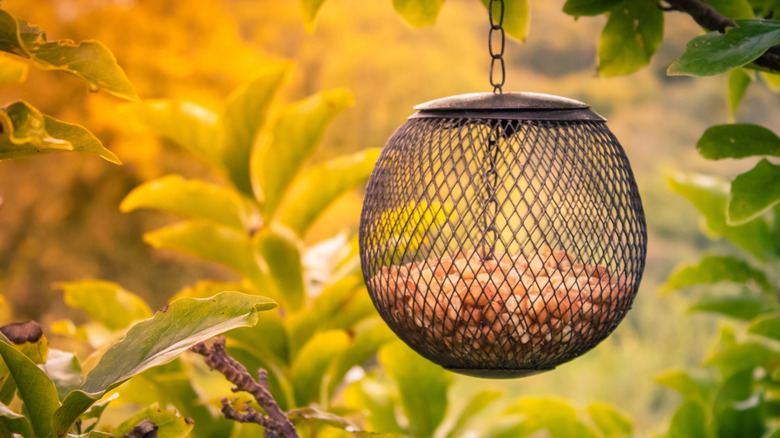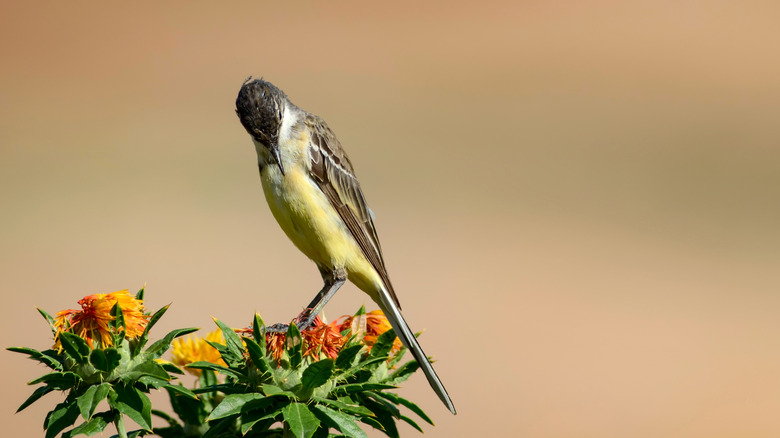The Interesting Reason Your Bird Feeder Is Causing Weeds To Grow In Your Yard
We may receive a commission on purchases made from links.
In addition to attracting sprightly cardinals and finches, bird feeders can introduce weeds in your yard. Weeds often result from a bird feeder blunder you might be making: choosing seed mixes brimming with red millet, milo, and other filler seeds most birds reject. These seeds fall to the ground and sprout near feeders. In some cases, they grow into noxious or invasive plants. Even if you avoid filler and buy low-waste birdseed, whose seeds have been hulled to prevent germination, or black-oil sunflower seeds, which most birds are unlikely to pass up, you may still find weeds by your feeders. Does it mean weed seeds have contaminated your feed? Probably not, says Mark McKellar, a wildlife biologist, bird supply shop owner, and creator of the YouTube channel Mark's BackYard Birds. That's because your feeders aren't just bird cafes. They're also bird latrines.
After gathering seeds and berries from nearby plants, birds may relieve themselves as they enjoy the bounty you're serving at your feeders. "Perches on bird feeders," McKellar explains, encourage "droppings to hit the ground right underneath." Seeds in these droppings are likely to germinate in wet spring soil. McKellar says this is often how poison ivy, whose berries nourish many birds, ends up by feeders and in other parts of the yard. In addition to arriving through bird droppings and birdseed filler, weed seeds make their way to feeders on the fur of rabbits, squirrels, and other animals that spend time nearby. Plus, wind may bring the seeds of dandelions and other problem plants to the area. Finding safe ways to manage these issues is key.
Controlling weeds near your bird feeders
You can't control what birds eat in local fields and forests, but you can shape which seeds and berries your yard has on the menu. Removing weeds from your yard before they go to seed can help a bit. Banishing thistle weeds from your yard is a good start, especially if invasive Canada thistle (Cirsium arvense) is crowding out native plants. Also, consider using a seed-catching tray — like the AUXPhome Multi-Purpose Bird Seed Catcher Hanging Tray — beneath each of your bird feeders. This can help prevent weeds by keeping errant seeds from entering the soil and germinating. When buying birdseed, look for varieties that have been baked to destroy weed seeds. Or offer bird foods that can't germinate, such as peanuts, mealworms, and sunflower hearts.
Even though Mark McKellar of Mark's Backyard Birds says that pre-emergent herbicides can be used beneath bird feeders, he recommends mowing as a chemical-free way to control existing weeds in areas where birds congregate. Mowing regularly discourages weeds from forming flowers and going to seed. It can also help grass thrive under your bird feeders and smother young weeds. Also, remember that certain plants that grow from birdseed can be beneficial. For example, sometimes an intact, unbaked sunflower seed will produce a plant. Though you might consider it an interloper, you could treat it as a welcome surprise and let the birds feast on the seeds it will eventually produce. Replacing bird feeders with sunflowers and other plants that fill bird bellies is a weed prevention strategy to consider, too.
Why to replace manmade feeders with bird-feeding plants
There are many beautiful plants that produce birdseed, bringing birds to your yard and garden. Strategically planting some of these species can reduce the need for bird feeders. These plants encourage birds to leave droppings among their foliage, which deprives weed seeds of sunlight. You're also likely to buy less commercial birdseed, which means fewer filler seeds that can turn into weeds.
Safflower (Carthamus tinctorius) is a plant so easy to grow that you might never need to buy birdseed again. In addition to drawing woodpeckers and nuthatches, it sports pretty golden flowers, isn't appealing to squirrels, and needs minimal water to survive. Pearl millet (Cenchrus americanus), a popular ornamental grass, also attracts a range of songbirds. A swath of purple coneflowers (Echinacea purpurea) can feed hungry chickadees and goldfinches well into the winter.
Also, consider growing fruit and berry trees that birds love in your yard. Cardinals, orioles, grosbeaks, and cedar waxwings all adore the fruit of serviceberry trees, which are native to much of North America. The common hackberry (Celtis occidentalis) is another fine choice. In addition to being native to 80 percent of the United States, its purple berries are a hit with woodpeckers and many other feathered friends. Plus, if birds accidentally plant serviceberries or hackberries, their seedlings are much easier to remove than noxious weeds found in some birdseed, including Canada thistle and field bindweed (Convolvulus arvensis).

